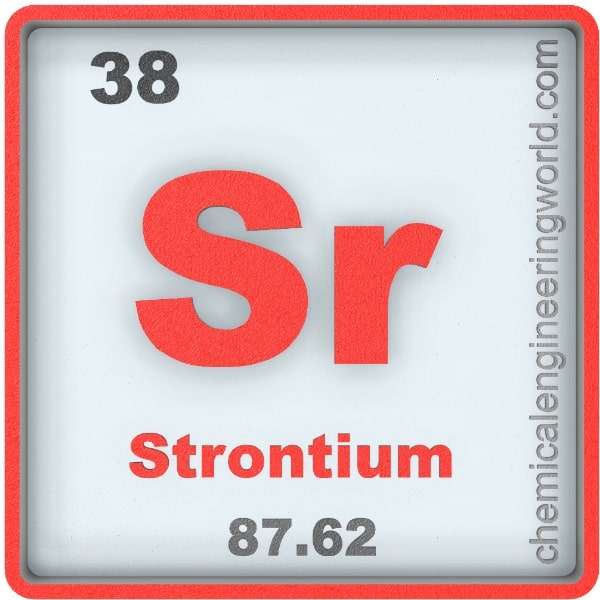Strontium Element Properties and Information

Strontium Element Properties and Information
Strontium is thirty-eight element on the periodic table. Elements are arranged in the periodic table on the basis of the atomic number. Atomic number is the number of protons in the nucleus of the atom. Strontium has an atomic number of 38. It is located in the Group 2 and Period 5 of the periodic table of elements. It is denoted by Sr. The name is derived from ‘Strontian’, a small town in Scotland.
Adair Crawford discovered an unusual rock in 1787 and named it Strontia. It was investigated by Thomas Charles Hopes in 1791 and he found that it contained a new element. Strontium metal itself was isolated by Humphrey Davy using method of electrolysis in 1808.
Strontium is mainly found in minerals; Strontianite and Celestite.
Physical Properties
- Strontium is a soft and silvery-white-yellowish metal.
- The atomic mass of strontium is 87.62
- The melting point of strontium is 769°C
- The boiling point of strontium is 1384°C
- The density of strontium is 2600 in S.I. units at 20°C
- There are four stable isotopes of strontium which occur naturally; strontium-84, strontium-86, strontium-87, and strontium-88.
Chemical Properties
- A dark oxide layer forms on strontium when it is exposed to air.
- Strontium reacts easily with water.
- Strontium reacts strongly with oxygen, it has to be stored under liquid hydrocarbon.
- Finely powdered strontium ignites spontaneously at room temperature. The flame is bright-red in colour.
Methods of Production
Reduction: The strontium containing ore is roasted with coal to form the sulfide. This is a dark coloured material, informally called black ash. It mostly contains strontium sulfide. The black ash is dissolved in water and filtered. Carbon dioxide is introduced to precipitate strontium carbonate.The strontium oxide is reduced with aluminium to obtain the strontium metal.
Relevance in Chemical and Related Industries
- Refining: Small amounts of strontium metal are used in the refining of zinc to remove small amounts of lead impurities.
- Paste: Strontium chloride is sometimes added in tooth pastes to cater to consumers who have sensitive teeth.
- Getter: Sometimes, strontium is used to react with unwanted gases in vacuum space.
Relevance in Other Industries
- Fireworks: About 5% of the total strontium production goes into the making of fireworks so that they impart deep-red colour.
- Magent: Strontium carbonate is used to make ferrite magnets.
- Archeology: Strontium isotopes ratios have been used to determine the source of ancient archeological materials. Also, they have been used to trace animal migration and in some cases, migration of humans as well.
- Toys: Strontium aluminate is used in glow in the dark toys as it is chemically inert.
Health Effects on Exposure
- Over-uptake: Causes problems in bone development.
- Radioactivity: Causes anemia and oxygen shortages, at high levels, increases risk of cancer.
Effects on Surroundings
- Disposal: One of the isotopes of strontium is radioactive in nature. Improper disposal, such as dumping in ground; will cause it to accumulate in soils and also move into the ground water. The proper way of disposal is through radioactive decay to form stable zirconium.
References:
https://en.m.wikipedia.org/wiki/Strontium
































